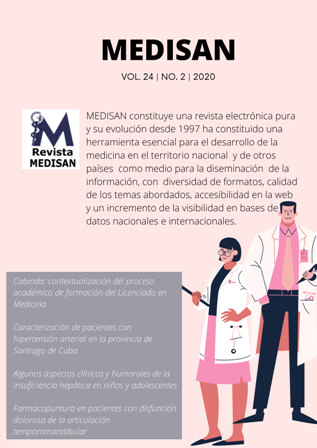Pharmacopuncture in patients with temporomandibular joint painful dysfunction
Keywords:
temporomandibular dysfunction syndrome, pharmacopuncture, Natural and Traditional Medicine.Abstract
Introduction: The temporomandibular dysfunction syndrome constitutes an important health problem that affects more than 50 % of the world population.
Objective: To describe the therapeutic clinical course of patients with temporomandibular affections treated with pharmacopuncture.
Methods: A descriptive study of 60 patients with temporomandibular dysfunction syndrome in acute phase was carried out, they were assisted in theFaustinoPérezClinicalSurgicalHospital fromMatanzas, from January to December,2018. A solution composed by lidocaine, B12 vitamin and betamethasone was administered in certain acupunctural points. Also, the pain verbal scale was used.
Results: It was found that the 60 years and over age group, as well as the female sex were those most affected. Of the factors associated to this syndrome stress prevailed in 100 % of patients; 63.3 % presented moderate pain and 53.3 % were totally relieved.
Conclusions: Pharmacopuncture relieved the pain associated with the temporomandibular dysfunction syndrome in most of those affected, in the first 3 treatment sessions.
Downloads
References
2. González García X, Cardentey García J, Porras Mitjans O, Corbillón Correa JC. Afecciones de la articulación temporomandibular en un servicio de urgencias estomatológicas. Rev Ciencias Médicas Pinar del Río. 2016 [citado 08/11/2018]; 20 (3). Disponible en: http://scielo.sld.cu/pdf/rpr/v20n3/rpr06316.pdf
3. Fuentes R, Ottone NE, Saravia D, Bucchi C. Irrigación e inervación de la articulación temporomandibular: Una Revisión de la Literatura. Int. J. Morphol. 2016 [citado 03/07/2017]; 34 (3): 1024-33. Disponible en: https://scielo.conicyt.cl/scielo.php?script=sci_arttext&pid=S0717-95022016000300034&lng=es
4. Vélez Uribe JD, Vélez LC, Pérez Mejía M, Barragán KA. Síndrome de disfunción de la articulación temporomandibular y el papel de la educación en su tratamiento. CES Movimiento y Salud. 2015 [citado 08/11/2018]; 3 (1): 44-52. Disponible en: http://webcache.googleusercontent.com/search?q=cache:8D1S_IUn9ygJ:revistas.ces.edu.co/index.php/movimientoysalud/article/download/3352/pdf_2+signos+y+sintoma+del+sindrome+de+atm&cd=14&hl=es&ct=clnk&gl=cu
5. Mehta NR. Síndrome del dolor miofascial. Manual MSD. Versión para profesionales. 2017 [citado 08/11/2018]. Disponible en: http://www.msdmanuals.com/es/professional/trastornos-odontol%C3%B3gicos/trastornos-temporomandibulares/s%C3%ADndrome-del-dolor-miofascial
6. Rotter BE. Temporomandibular joint disorders. In: Flint P, Haughey BH, Lund V, Niparko J, Robbins K, Regan Thomas J, et al. Cummings Otolaryngology. 6th ed. Philadelphia, PA: Elsevier Saunders; 2014. p. 91.
7. Santos Ramírez C. Manejo clínico y farmacológico de los cuadros articulares inflamatorios de la ATM. 2014 [citado 08/11/2018]. Disponible en: http://airemb.es/wp-content/uploads/2016/01/airemb-profesionales-presentaciones-manejo-clinico-y-farmacologico-de-los-cuadros-articulares-inflamatorios-de-la-atm.pdf
8. Ferriol Rodríguez MR, Urbay Ceballos F, Rodríguez Domínguez J, Fariñas Costa D, Momplet Pérez V, Benavides Fleites N. La farmacopuntura en el síndrome del hombro doloroso. AMC. 2017 [citado 08/11/2018]; 11 (3). Disponible en: http://www.medigraphic.com/pdfs/medicadelcentro/mec-2017/mec173b.pdf
9. Frómeta Hernández H, Jach Ravelo M. Aplicación de la farmacopuntura en el tratamiento de la epicondilitis. Revista Cubana de Medicina Natural y Tradicional. 2016 [citado 08/11/2018]; 1 (1). Disponible en: http://www.revmnt.sld.cu/index.php/rmnt/article/view/14
10. Mehta NR. Artritis de la articulación temporomandibular (ATM). Manual MSD. Versión para profesionales. 2017 [citado 08/11/2018]. Disponible en: http://www.msdmanuals.com/es-pe/professional/trastornos-odontol%C3%B3gicos/trastornos-temporomandibulares/artritis-de-la-articulaci%C3%B3n-temporomandibular-atm
11. Troya Borges E, Martínez Abreu J, Padilla Suárez E, Rodríguez Ramos SL, Mirabal Peón MS, Matos Campos MR. Intervención dirigida a médicos de la familia sobre el síndrome de disfunción temporomandibular. Rev. Med. Electrón. 2015 [citado 01/09/2017]; 37 (4): 333-44. Disponible en: http://scielo.sld.cu/scielo.php?script=sci_arttext&pid=S1684-18242015000400004&lng=es
12. Noguera Planas MR, Molinet Mompié GI, Diz Suárez GC. Oclusión traumática y bruxismo en la disfunción temporomandibular. Multimed. 2015 [citado 01/09/2017]; 19 (6). Disponible en: http://www.revmultimed.sld.cu/index.php/mtm/article/view/431/689
13. Cabrera Villalobos Y, Álvarez Llanes M, Gómez Mariño M, Malcom Castillo ME. Oclusión y estrés en el síndrome dolor-disfunción temporomandibular: presentación de un paciente. AMC. 2009 [citado 01/09/2017]; 13 (3). Disponible en: http://revistaamc.sld.cu/index.php/amc/article/view/2409/850
14. Cabo García R, Grau León IB, Lorenzo Uribazo AM. Apuntes sobre el envejecimiento del sistema estomatognático. Revisión de la literatura. Medisur. 2016 [citado 31/08/2017]; 14 (3): 307-12. Disponible en: http://scielo.sld.cu/scielo.php?script=sci_arttext&pid=S1727-897X2016000300013&lng=es.
15. Espinoza Villanueva CJ. Relación entre depresión y trastornos temporomandibulares en pacientes adolescentes Huanuco 2015. Informe final de tesis para optar el grado académico de cirujano dentista. Huanuco: Universidad de Huanuco; 2016 [citado 31/08/2017]. Disponible en: http://repositorio.udh.edu.pe/bitstream/handle/123456789/281/Christian%20Joan%20Espinoza%20Villanueva.pdf?sequence=1&isAllowed=y
16. Bono AE. La artritis reumatoidea en la articulación temporomandibular. Hallazgos clínicos, radiográficos y serológicos. Tesis de Doctorado. SEDICI. 2009 [citado 31/08/2017]. Disponible en: http://sedici.unlp.edu.ar/handle/10915/51848
17. Ibáñez Mancera NG, Vinitzky Brener I, Muñoz López S, Irazoque Palazuelos F, Arvizu Estefania C, Amper Polak T. Disfunción de la articulación temporomandibular en pacientes con artritis reumatoide. Rev Esp Cirug Oral y Maxilofac. 2017 [citado 08/11/2018]; 39 (2). Disponible en: http://www.sciencedirect.com/science/article/pii/S1130055816300338
18. Mendiburu Zavala CE, Peñaloza Cuevas R, Carrillo Mendiburu J, Cárdenas Erosa RA, Cortés Carrillo D, Cervera Gasque JE. Signos y síntomas en la articulación temporomandibular de sujetos geriátricos con artritis, antes-después de fisioterapia. ODOVTOS-Int. J. Dent. Sc. 2016; 18 (2):51-9.
Published
How to Cite
Issue
Section
License
All the articles can be downloaded or read for free. The journal does not charge any amount of money to the authors for the reception, edition or the publication of the articles, making the whole process completely free. Medisan has no embargo period and it is published under the license of Creative Commons, International Non Commercial Recognition 4.0, which authorizes the copy, reproduction and the total or partial distribution of the articles in any format or platform, with the conditions of citing the source of information and not to be used for profitable purposes.





